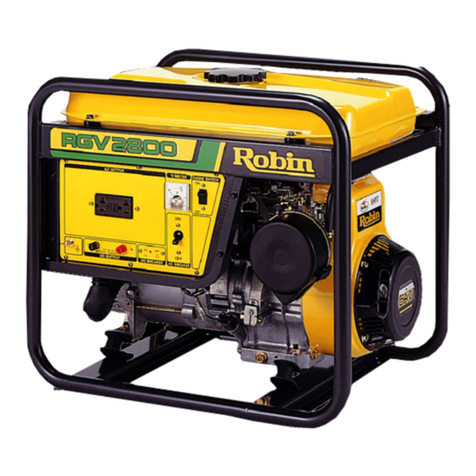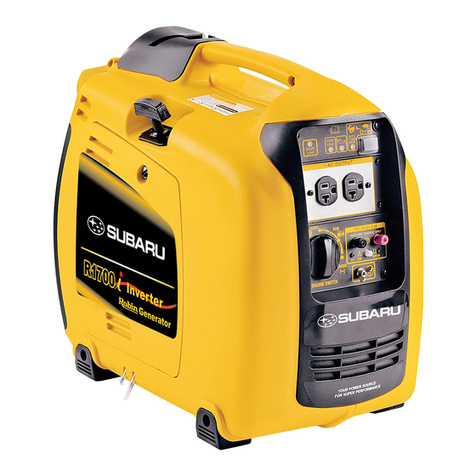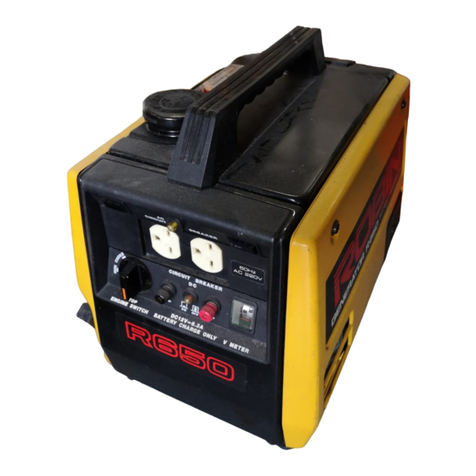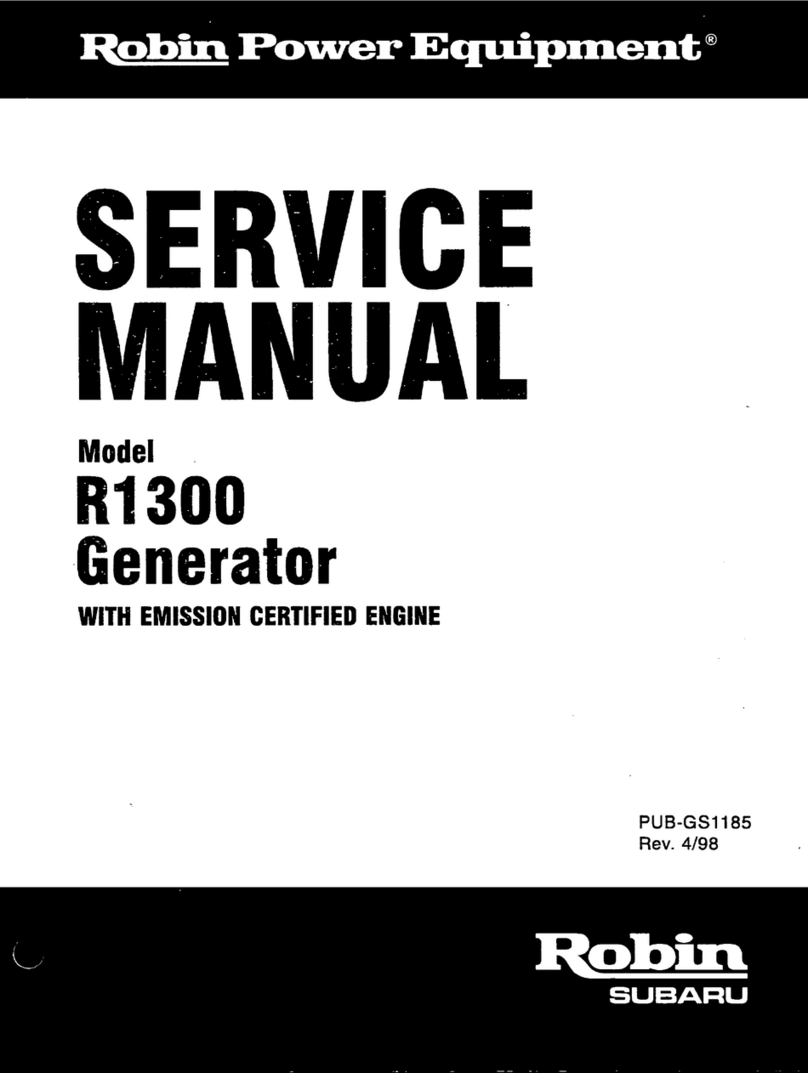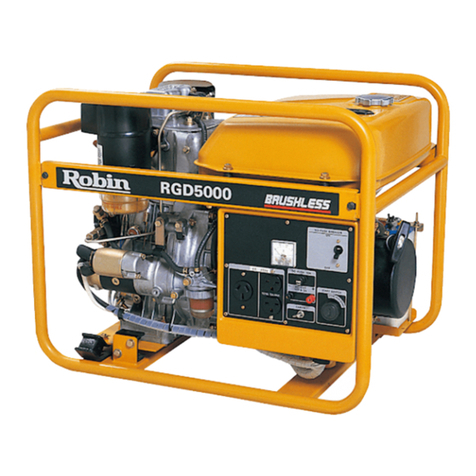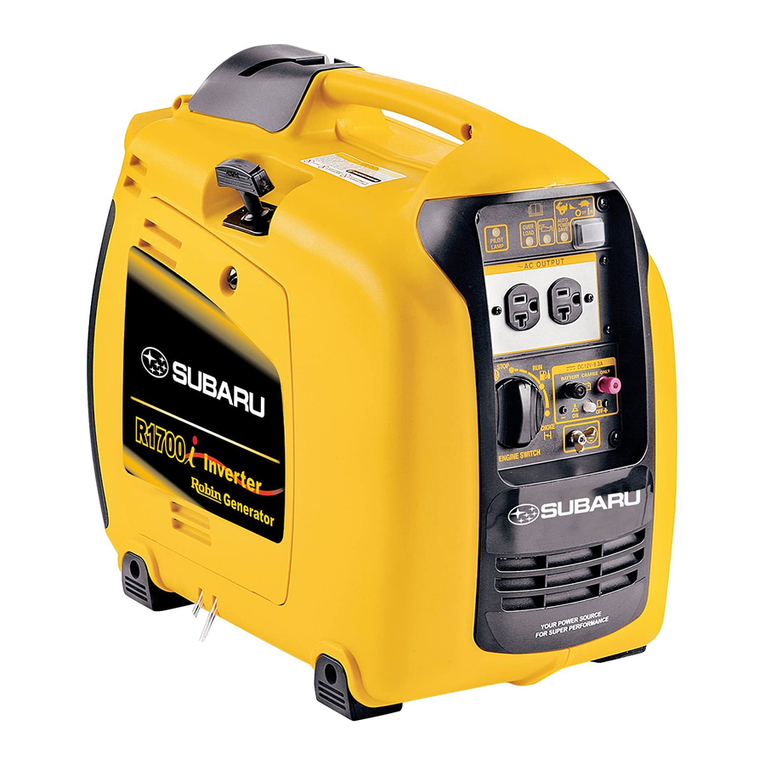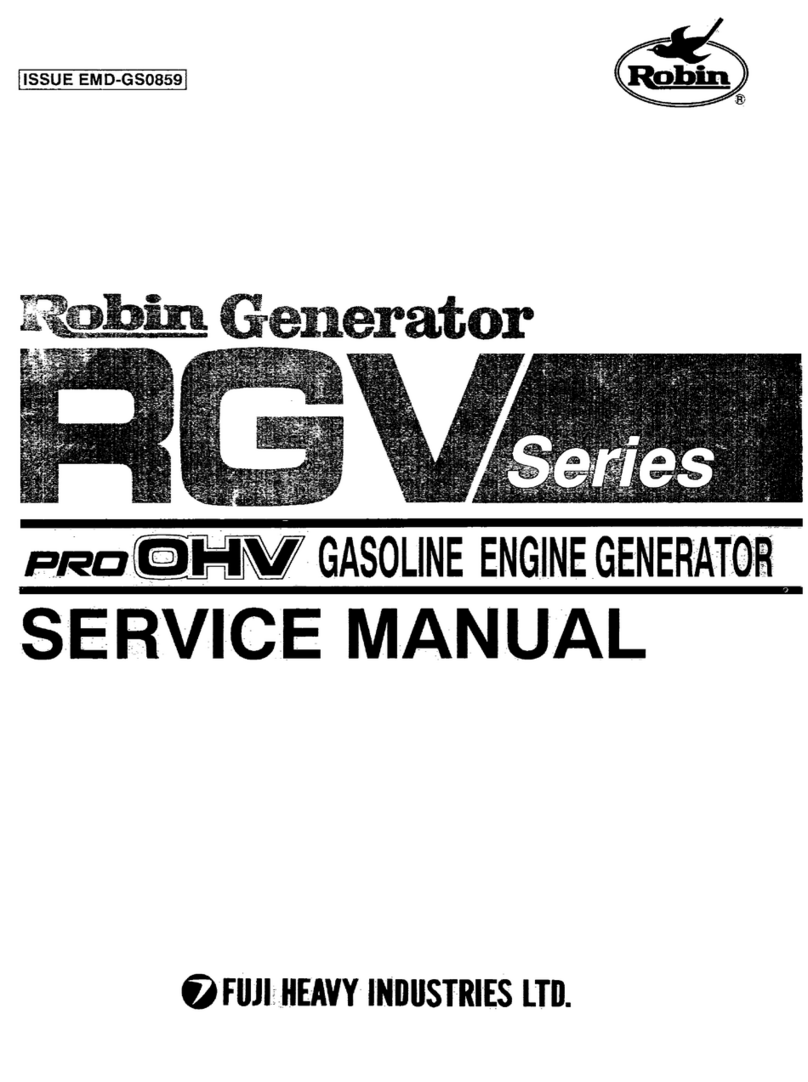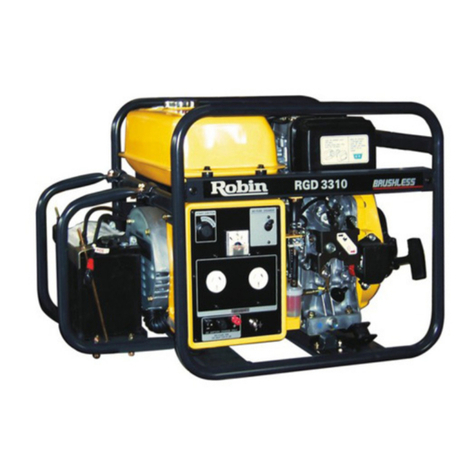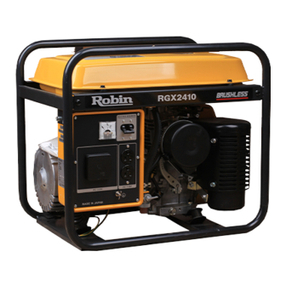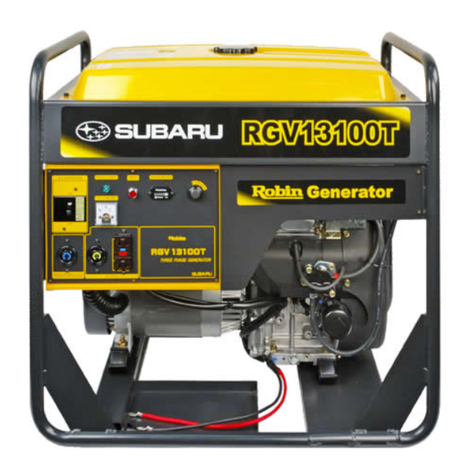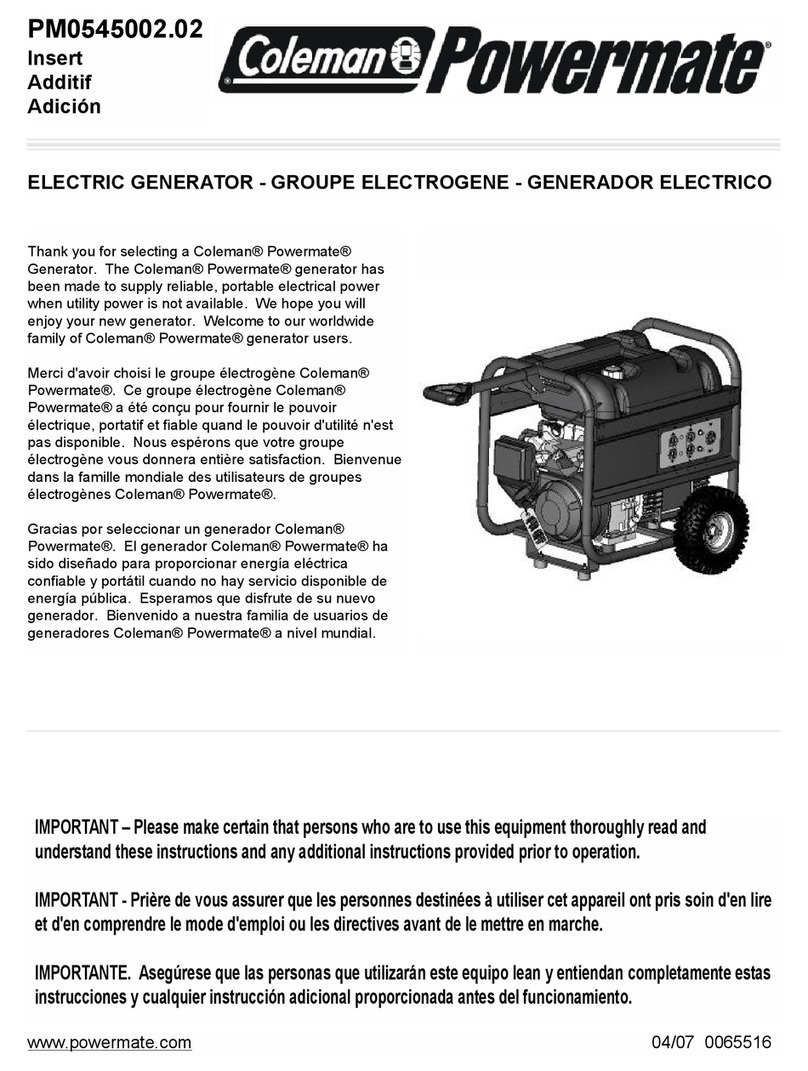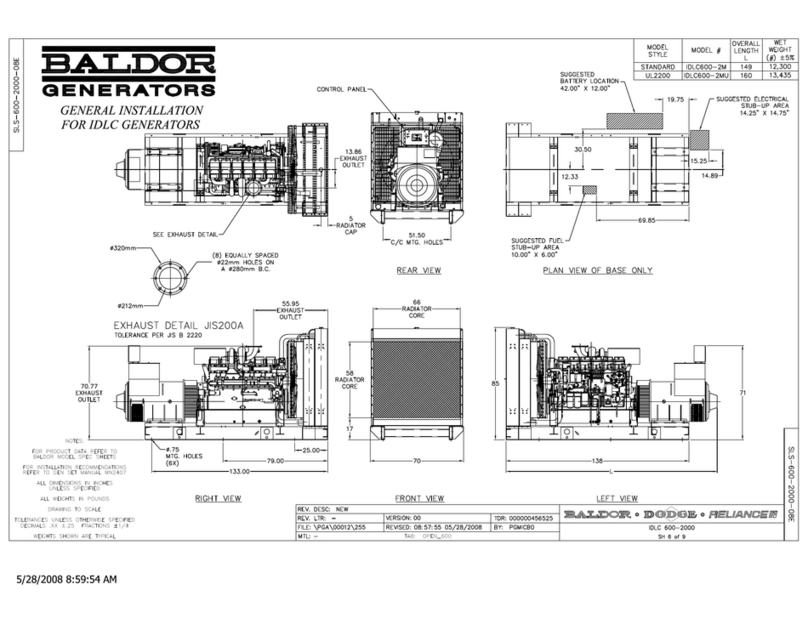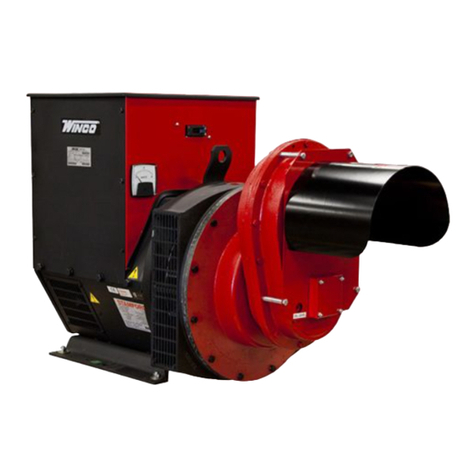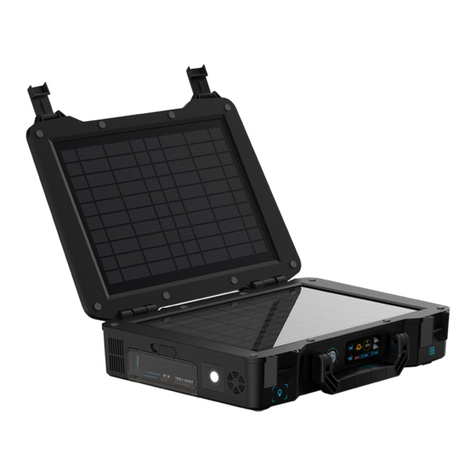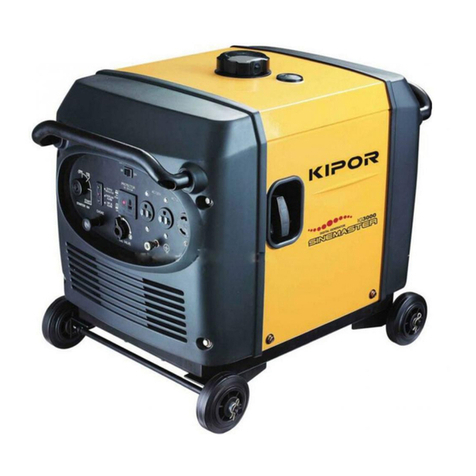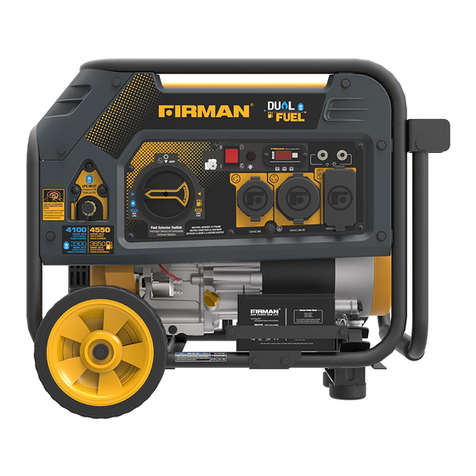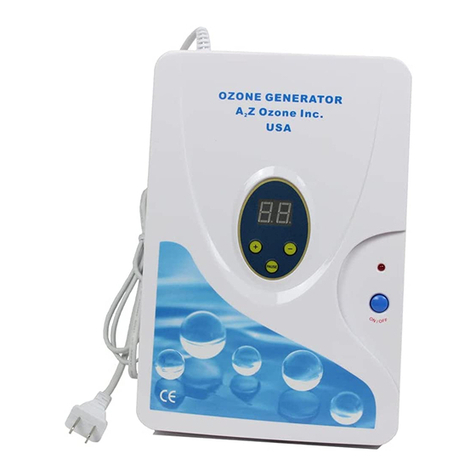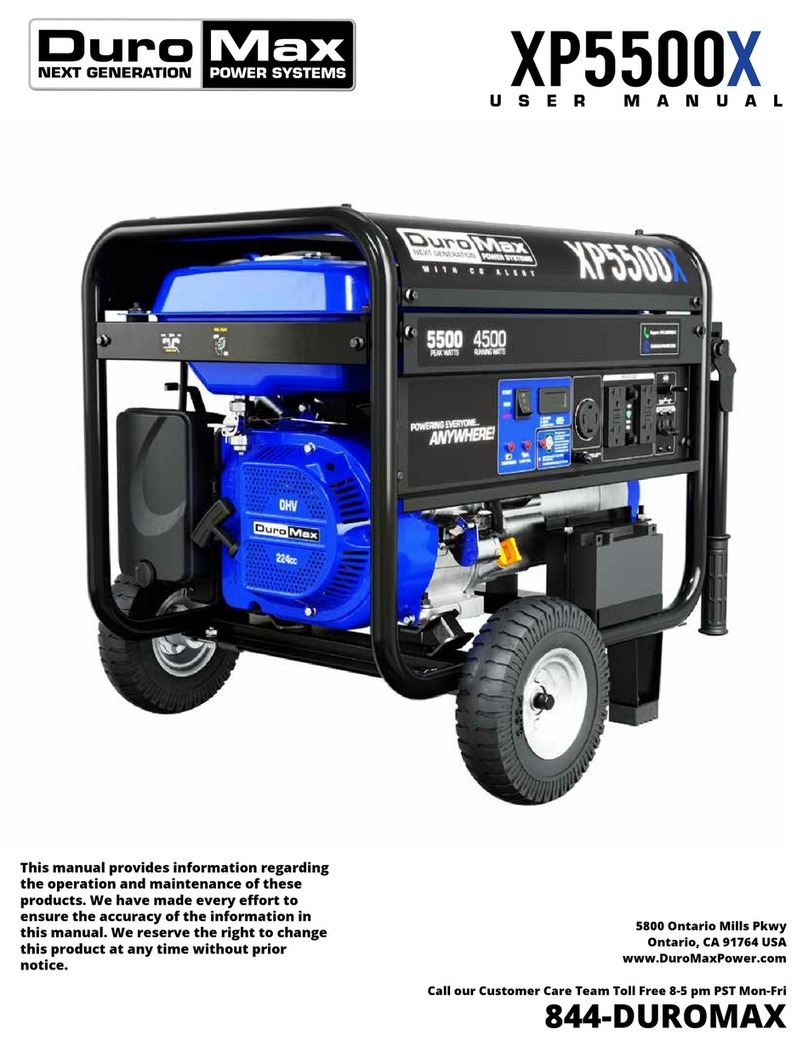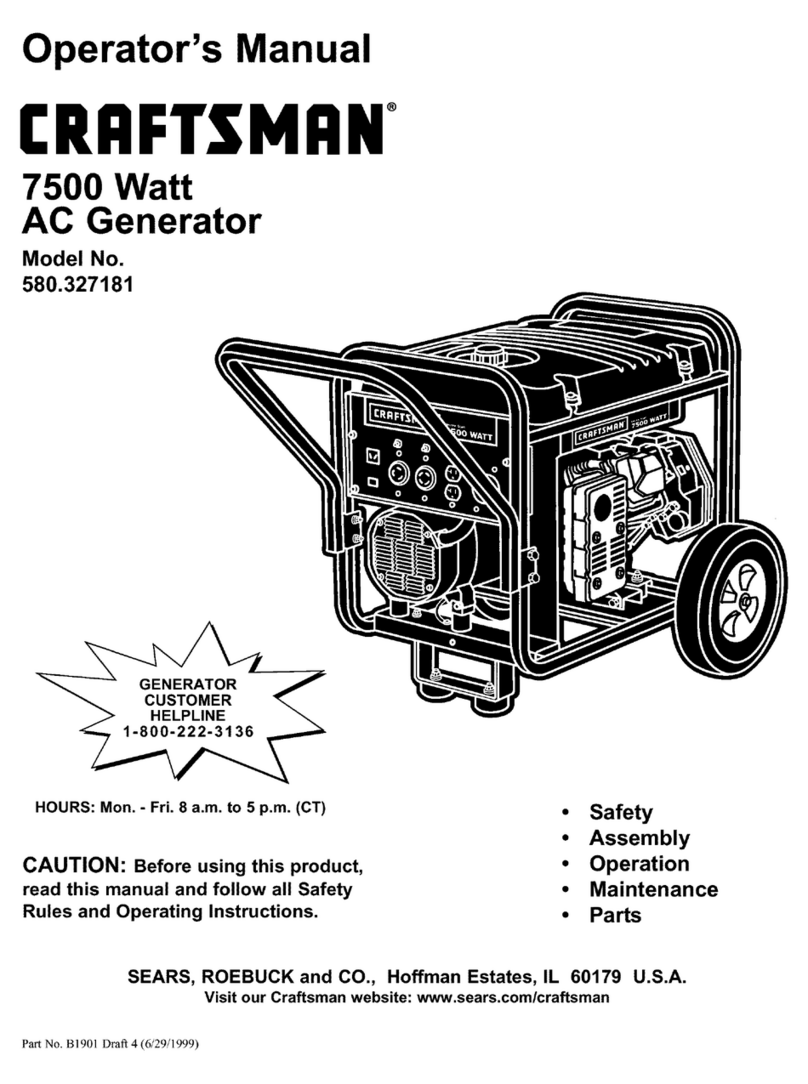Robin R 1700i User manual

ISSUE EMD-GU7322
3ZZ9020171
PRINTEDINCHINA
November2011
海外一般

17
R1700i (50Hz-220/240V, 60Hz-220/240V, 50Hz-240V)

R1700igenGU7322.indd01R1700igenGU7322.indd01 2011/11/2113:34:182011/11/2113:34:18

R1700igenGU7322.indd02R1700igenGU7322.indd02 2011/11/2113:34:192011/11/2113:34:19

1
PROD No. SER No.
(Label)
FOREWORD
Thank you very much for purchasing a ROBIN GENERATOR.
This manual covers operation and maintenance of the ROBIN GENERATOR.
This ROBIN GENERATOR can be used for general electrical equipments, appliances, lamps,
tools as an AC power source. With regards to DC application, the terminals are used only for
charging12voltbattery.
Never use this generator for any other purposes.
Please take a moment to familiarize yourself with the proper operation and maintenance
procedures in order to maximize the safe and efficient use of this product.
Keep this owner’s manual at hand, so that you can refer to it at any time.
Due to constant efforts to improve our products, certain procedures and specifications are
subject to change without notice.
When ordering spare parts, always give us the MODEL, PRODUCTION NUMBER (PROD No.)
and SERIAL NUMBER (SER No.) of your Product.
Please fill in the following blanks after checking the production number on your product.
(Location of label is different depending on the product model.)
NOTE Please refer to the illustrations on the back page of the front
cover or back cover for Fig. to indicated in the sentence.
1. SAFETY PRECAUTIONS. . . . . . . . . . . . . . . . . . . . . . . . . . . . . . . . . . . . . . . . . . . . . . 2
2. COMPONENTS . . . . . . . . . . . . . . . . . . . . . . . . . . . . . . . . . . . . . . . . . . . . . . . . . . . . . 5
3. CONTROLS AND INDICATORS . . . . . . . . . . . . . . . . . . . . . . . . . . . . . . . . . . . . . . . . 5
4. PRE-OPERATION CHECKS . . . . . . . . . . . . . . . . . . . . . . . . . . . . . . . . . . . . . . . . . . . 6
5. OPERATING PROCEDURES . . . . . . . . . . . . . . . . . . . . . . . . . . . . . . . . . . . . . . . . . . 8
6. WATTAGE INFORMATION . . . . . . . . . . . . . . . . . . . . . . . . . . . . . . . . . . . . . . . . . . . . 10
7. MAINTENANCE SCHEDULE. . . . . . . . . . . . . . . . . . . . . . . . . . . . . . . . . . . . . . . . . . . 11
8. "HOW-TO" MAINTENANCE. . . . . . . . . . . . . . . . . . . . . . . . . . . . . . . . . . . . . . . . . . . . 12
9. PERIODIC OPERATION AND INSPECTION . . . . . . . . . . . . . . . . . . . . . . . . . . . . . . 13
10. TRANSPORTING . . . . . . . . . . . . . . . . . . . . . . . . . . . . . . . . . . . . . . . . . . . . . . . . . . . 13
11. PREPARATION FOR STORAGE . . . . . . . . . . . . . . . . . . . . . . . . . . . . . . . . . . . . . . . 14
12. TROUBLESHOOTING . . . . . . . . . . . . . . . . . . . . . . . . . . . . . . . . . . . . . . . . . . . . . . . 14
13. SPECIFICATIONS. . . . . . . . . . . . . . . . . . . . . . . . . . . . . . . . . . . . . . . . . . . . . . . . . . . 15
14. WIRING DIAGRAM . . . . . . . . . . . . . . . . . . . . . . . . . . . . . . . . . . . . . . . . . . . . . . . . . . 16
CONTENTS Page
R1700igenGU7322.indd1R1700igenGU7322.indd1 2011/11/2113:34:192011/11/2113:34:19

2
1. SAFETY PRECAUTIONS
Please make sure you review each precaution carefully.
Pay special attention to statement preceded by the following words.
WARNING
“WARNING” indicates a strong possibility of severe personal injury or loss
of life if instructions are not followed.
CAUTION
“CAUTION” indicates a possibility of personal injury or
equipment damage if instructions are not followed.
WARNING
Do not place in flammables near the generator.
Be careful not to place fuel, matches, gunpowder, oily cloths, straw, trash, or any other in flammables near
the generator.
WARNING
Do not enclose the generator nor cover it with a box.
The generator has a built-in forced air cooling system, and may become overheated if it is enclosed.
If generator has been covered to protect it from the weather during non use, be sure to remove it and keep
it well away from the area during generator use.
WARNING
Operate the generator on a level surface.
It is not necessary to prepare a special foundation for the generator.
However, the generator will vibrate on an irregular surface, so choose a level place without surface
irregularities.
If the generator is tilted or moved during operation, fuel may spill and / or the generator may tip over,
causing a hazardous situation.
Proper lubrication cannot be expected if the generator is operated on a steep incline or slope. In such a
case, piston seizure may occur even if the oil is above the upper level.
WARNING
Do not operate the generator near gasoline or gaseous fuel because of the potential
danger of explosion or fire.
Do not fill the fuel tank with fuel while the engine is running.
Do not smoke or use open flame near the fuel tank. Be careful not to spill fuel during
refueling. If fuel is spilt, wipe it off and let dry before starting the engine.
WARNING
Pay attention to the wiring or extension cords from the generator to the connected
device.
If the wire is under the generator or in contact with a vibrating part, it may break and
possibly cause a fire, generator burnout, or electric shock hazard.
Replace damaged or worn cords immediately.
WARNING
Do not operate the generator inside a room, cave, tunnel, or other insufficiently
ventilated area. Always operate it in a well-ventilated area, otherwise the engine
may become overheated, and the poisonous carbon monoxide gas contained in
the exhaust gases will endanger human lives.
Keep the generator at least 1 meter (3 feet) away from any structure or building
during use.
If the generator must be used indoors, the area must be well-ventilated and
extreme caution must be taken regarding the discharge of exhaust gases.
1m
1m
R1700igenGU7322.indd2R1700igenGU7322.indd2 2011/11/2113:34:192011/11/2113:34:19

3
WARNING
Do not operate in rain, in wet or damp conditions, or with wet hands.
The operator may suffer severe electric shock if the generator is wet due to rain or snow.
WARNING
If wet, wipe and dry it well before starting.
Do not pour water directly over the generator, nor wash it with water.
WARNING
Be extremely careful that all necessary electrical grounding procedures are followed during each and every
use.Failure to do so can be fatal.
WARNING
It is absolutely essential that you know the safe and proper use of the power tool or appliance that you
intend to use.
All operators must read, understand and follow the tool/appliance owners manual. Tool and appliance
applications and limitations must be understood. Follow all directions given on labels and warnings.
Keep all instruction manuals and literature in a safe place for future reference.
WARNING
Use only "LISTED" extension cords.
When a tool or appliance is used outdoors, use only extension cords marked "For Outdoor Use".
Extension cords, when not in use should be stored in a dry and well ventilated area.
WARNING
Always switch off generator's AC circuit breaker and disconnect tools or appliances when not in use,
before servicing, adjusting, or installing accessories and attachments.
WARNING
Keep children and all bystanders at a safe distance from work areas.
CAUTION
Make sure the engine is stopped before starting any maintenance, servicing or repair.
Make sure maintenance and repair of the generator set are performed by properly trained personnel only.
WARNING
Do not contact the generator to a commercial power line.
Connection to a commercial power line may short circuit the generator and ruin it or cause
electric shock hazard.
Use the transfer switch for connecting to domestic circuit.
WARNING
No smoking while handling the battery.
The battery emits flammable hydrogen gas, which can explode if exposed to electric
arcing or open flame.
Keep the area well-ventilated and keep open flames/sparks away when handling the
battery.
WARNING
Engine becomes extremely hot during and for some time after operation.
Keep combustible materials well away from generator area.
Be very careful not to touch any parts of the hot engine especially the muffler area or
serious burns may result.
R1700igenGU7322.indd3R1700igenGU7322.indd3 2011/11/2113:34:202011/11/2113:34:20

4
R1700igenGU7322.indd4R1700igenGU7322.indd4 2011/11/2113:34:202011/11/2113:34:20

5
2. COMPONENTS (See Fig. )
3. CONTROLS AND INDICATORS
Please refer to the illustrations on the back
page of the front cover or back cover for Fig.
to indicated in the sentence.
❶RECOIL STARTER (HANDLE)
❷CONTROL PANEL
❸SIDE PANEL (L)
❹AIR CLEANER*
❺FUEL DRAIN SCREW
❻CARRING HANDLE
❼TANK CAP COVER
❽EXHAUST OUTLET
❾OIL DRAIN PLUG
❿SIDE PANEL (R)
⓫OIL GAUGE (OIL FILLER)**
⓬SPARK PLUG CAP**
* :Inside the SIDE PANEL (L)
** :Inside the SIDE PANEL (R)
CONTROL PANEL
❶PILOT LAMP
❷OVERLOAD LAMP
❸OIL SENSOR LAMP
❹AUTO POWER SAVE LAMP
❺AUTO POWER SAVE SWITCH
❻AC RECEPTACLES
❼DC TERMINALS
❽DC CIRCUIT BREAKER
❾GROUND TERMINAL
❿ENGINE SWITCH
ENGINE SWITCH (See Fig. -①)
The engine switch is designed for easy operation
with the interlocking mechanism between the fuel
valve and the choke furnished.
CHOKE To start the engine, turn the knob to
the position.(Choke valve is closed.)
RUN Keep the knob in this position after
the engine starts.(The engine can be
started with the knob at this position
when the engine is warm.)
STOP To stop the engine, return the knob to
the position.
(The fuel valve is closed as well.)
PILOT LAMP and OVERLOAD LAMP
(See Fig. -②)
These lamps are turned on in the following
conditions;
PILOT LAMP (Green)
----- The lamp is turned on
while generating properly.
OVERLOAD LAMP (Red)
--- The lamp is turned on in
the overload condition.
* The breaker will be activated after the lamp is
turned on for 20 seconds in the 120% electric
power condition, and results in no load condition.
* If the lamp is turned on, stop and start the engine
again to resume the operation.
CAUTION
The lamp will be flashed in case of poor
engine performance due to clogged spark
arrester.In this case, clean the spark
arrester. (Refer to "SPARK ARRESTER")
OIL SENSOR LAMP (See Fig. -③)
When the level of the engine oil falls below the
prescribed value, the alarm lamp lights up and the
engine stops automatically.
When the engine stops due to oil shortage, it can
not be started anymore even by pulling the start
knob (just the alarm lamp flickers).
In such a case, replenish engine oil up to the
mouth of the oil filling port.
(Refer to page 6 for details about the oil
replenishing procedure).
(See Fig. )
NOTE
R1700igenGU7322.indd5R1700igenGU7322.indd5 2011/11/2113:34:202011/11/2113:34:20

6
AUTO POWER SAVE SWITCH AND
LAMP
(See Fig. -④)
With the switch in the “ ” marking position, the
engine speed is reduced automatically when no
electricity is taken out, while the engine speed is
automatically adjusted in accordance with the load
condition when the electricity is taken out.
When using in the heavy load condition, set the
switch into the “ ” marking position to maintain
the electric power level in the stable condition.
When using DC power, turn the switch into the
“OFF” position.
DC CIRCUIT BREAKER (See Fig. -⑤)
DC circuit breakers shut off electric current when
the current exceeds its limit or a malfunction
occurs in the connected appliance.
Check for excessive current consumption or
defects in the appliance. After making sure
everything is in order, push the button to the " ON
" position.
❶BUTTON ❸IN(ON)
❷KNOB ❹OUT(OFF)
CAUTION
If circuit breaker continues to be activated,
discontinue use and check generator and/
or appliance for malfunction with their
respective service representatives.
Never interfere with the operation of the
circuit breaker knob or keep pushing it in
the "ON" position.
FUEL TANK CAP (See Fig. -⑥)
The fuel tank cap is located behind the cover.
To open the cover, lift up with the dent portion
depressed backward as shown in the illustration.
Remove the fuel tank cap by turning
counterclockwise.
❶FUEL TANK CAP
❷FUEL FILTER SCREEN
❸TANK CAP COVER
SIDE PANEL (L.R.) (See Fig. -⑦)
To access the following items for servicing, take
the applicable side panel out by removing the
screw with screwdriver or coin.
LH-side panel-----Air cleaner etc.
RH-side panel-----Oil level gauge, Ignition coil,
Spark plug etc.
4. PRE-OPERATION CHECKS
1. CHECK ENGINE OIL
(See Fig. -①,②)
Before checking or refilling oil, be sure generator
is located on stable and level surface with engine
stopped.
■Remove oil filler cap and check the engine oil
level.
■If oil level is below the lower level line, refill with
suitable oil (see table) to upper level line. Do
not screw in the oil filler cap when checking oil
level.
■Change oil if contaminated.
(See "How-To" Maintenance.)
Oil capacity . . . . . . . . . . . 0.36 liters
Recommended engine oil:
Use 4-stroke automotive detergent oil of API
service class SE or higher grade (SG, SH or SJ is
recommended). SAE 10W-30 or 10W-40 is
recommended for general, all-temperature use. If
single viscosity oil is used, select the appropriate
viscosity for the average temperature in your area.
2. CHECK ENGINE FUEL
(SeeFig. -⑥, -③)
WARNING
Do not refuel while smoking or near open
flame or other such potential fire hazards.
Otherwise fire accident may occur.
■If fuel level is low, refill with unleaded
automotive gasoline.
(See Fig. )
R1700igenGU7322.indd6R1700igenGU7322.indd6 2011/11/2113:34:202011/11/2113:34:20

7
■Use unleaded automotive gasoline only.
•Unleaded regular/premium or reformulated
gasoline containing no more than 10%
Ethanol (E10), or 15% MTBE may also be
used.
• Never use gasoline containing ethanol
exceeding 10%, or MTBE exceeding 15%
because engine or fuel system damage could
result.
• Never use stale or contaminated gasoline.
• Use of these non-recommended fuels may
result in reduced performance and/or denial
of warranty.
■Stop the engine and open the cap.
■Close the fuel valve before filling the fuel tank.
■Fuel level should never over the RED marking
at the inlet portion. (SeeFig. -③-❶)
❶RED MARKING
■Be sure to use the fuel filter screen on the fuel
filter neck. (SeeFig. -⑥)
❶FUEL TANK CAP
❷FUEL FILTER SCREEN
❸TANK CAP COVER
Fuel tank capacity. . . . . . 3.5 liters
■When using the generator first time or stopping
due the fuel running out, pull the recoil handle
several times after filling fuel up to the RED
marking at the inlet portion of the fuel tank.
WARNING
Make sure you review each warning in
order to prevent fire hazard.
■Do not refill tank while engine is running
or hot.
■Before filling fuel, turn the engine switch
into " " (STOP) position.
■Be careful not to admit dust, dirt, water or
other foreign objects Into fuel.
■Wipe off spilt fuel thoroughly before
starting engine.
■Keep open flames away.
3. CHECKING COMPONENT PARTS
Check following items before starting engine:
■Fuel leakage from fuel hose, etc.
■Bolts and nuts for looseness.
■Components for damage or breakage.
■Generator not resting on or against any
adjacent wiring.
4. CHECK GENERATOR
SURROUNDINGS.
■When listening the radio near by the generator,
the radio sound may be disturbed on account
of the radio wave condition and the radio
performance.
WARNING
Make sure you review each warning in
order to prevent fire hazard.
■Keep area clear of in flammables or other
hazardous materials.
■Keep generator at least 1 meter away from
buildings or other structures.
■Only operate generator in a dry, well
ventilated area.
■Keep exhaust pipe clear of foreign
objects.
■Keep generator away from open flame. No
smoking!
■Keep generator on a stable and level
surface.
■Do not block generator air vents with
paper or other material.
5. GROUNDING THE GENERATOR
■To ground the generator to the earth, connect
the grounding lug of the generator to the
grounding spike driven into the earth or to the
conductor which has been already grounded to
the earth. (See Fig. -④)
■If such grounding conductor or grounding
electrode is unavailable, connect the grounding
lug of the generator to the grounding terminal
of the using electric tool or appliance.
(See Fig. -④)
❶GROUND TERMINAL
❷GROUNDING SPIKE
R1700igenGU7322.indd7R1700igenGU7322.indd7 2011/11/2113:34:212011/11/2113:34:21

8
5. OPERATING PROCEDURES
(See Fig. )
1. STARTING THE GENERATOR
CAUTION
Check the oil level before each operations
as outlined on page 6.
(a) Make sure the appliance is disconnected.
(b) Turn engine switch to " "(CHOKE) position.
(When engine is warm or temperature is high,
start engine with the switch at " " (RUN)
position.) (See Fig. -①)
CAUTION
■Do not connect defective appliances
including lines and plugs.
■Be sure appliances are not connected to
generator when starting up.
Starting the generator with an appliance
connected could result in damage to
the generator and/or appliance and in
personal injury.
(c) Pull the starter handle slowly until passing the
compression point (resistance will be felt), then
return the handle to its original position and pull
briskly. (See Fig. -②)
❶RECOIL STARTER HANDLE
❷PULL BRISKLY
(d) After starting, allow the starter handle to return
to its original position with the handle still in
your hand.
NOTE
When engine fails to start after several attempts,
repeat the starting procedures mentioned above
with the engine switch placed at " " (RUN)
position.
(e) After 20 to 30 seconds of warm-up is
completed, turn the engine switch to " "
(RUN) position.(See Fig. -③)
(f) Make sure the pilot lamp is on. This indicates
that the generator is properly operating.
NOTE
Please consult with the authorized ROBIN dealer
if the pilot lamp is turned off during the proper
operation.
2. USING ELECTRIC POWER
WARNING
■Make sure that the appliance is switched
OFF before connecting it to the generator.
■Do not move the generator while it is
running.
■Be sure to ground the generator if the
connected appliance is grounded. Failure
to ground unit may lead to electrical
shock.
(1) AC APPLICATION (See Fig. -④)
(a) Make sure the pilot lamp is turned on.
(b) Turn off the switch(es) of the electrical
appliance(s) before connecting to the generator.
(c) Insert the plug(s) of the electrical appliance(s)
into the receptacle.
WARNING
■Be sure to ground the generator if the
connected electrical device is grounded.
■Failure to ground unit could lead to
electrical spark.
CAUTION
Do not put foreign objects into the plug
receptacle.
■Check the amperage of the receptacles, and
be sure not to take a current exceeding the
specified amperage.
■Be sure that the total wattage of all appliances
dose not exceed the rated output of the
generator.
NOTE
If the generator is stopped with the overload
pilot lamp turned on, the generator will be in
the overload condition and/or the electrical
appliance(s) would be out of order.
In this case, stop the engine immediately
and check the appliance and/or generator for
overloading.
After the check and remedy, restarting the engine
will resume displaying in the normal manner.
(d) Turn on the switch of the appliance.
R1700igenGU7322.indd8R1700igenGU7322.indd8 2011/11/2113:34:212011/11/2113:34:21

9
(2) DC APPLICATION (See Fig. -⑤)
The DC terminal is used only for charging 12 volt
batteries. It provides up to 12V-8.3A (100W) of
maximum power.
❶Positive terminal (RED)
❷Negative terminal (BLACK)
CONNECTION OF CABLE :
■Connect positive terminal (red) on generator to
positive (+) terminal on battery.
■Connect negative terminal (black) on generator
to negative (-) terminal on battery.
SAFETY PRECAUTIONS WHILE
CHARGING
■An explosive hydrogen gas is discharged
through vent holes in the battery during the
charging process. Do not allow spark or open
flame around the generator or battery during
the charging process.
■Electrolyte fluid can burn eyes and clothing.
Be extremely careful to avoid contact. If injured,
wash the affected area immediately with large
quantities of water and consult a doctor for
treatment.
■When charging a large capacity battery or
totally discharged battery, excessive current
may force the DC breaker to turn off.
In such cases, use a battery charger to charge
a large battery with AC output.
■Battery defects may cause the DC breaker to
turn off.
Check the battery before replacing the DC
breaker.
3. STOPPING THE GENERATOR
(a) Turn off the power switch of the electric
equipment and unplug the cord from receptacle
of the generator.
(b) Allow the engine about 3 minutes to cool down
at no load before stopping.
(c) Turn the engine switch to the position " "
(STOP).
(See Fig. -⑥)
4. OIL SENSOR (See Fig. -⑦)
(a) The oil sensor detects the fall in oil level in the
crankcase and automatically stops the engine
when the oil level falls below a predetermined
level.
(b) When engine has stopped automatically, switch
off generator's AC circuit breaker, and check
the oil level.
Refill engine oil to the upper level as instructed
on page 6 and restart the engine.
(c) If the engine dose not start by usual starting
procedures, check the oil level
❶OIL SENSOR
CAUTION
Do not remove OIL SENSOR PROBE when
refilling with oil.
Remove oil filler cap on the opposite side
of carburetor.
R1700igenGU7322.indd9R1700igenGU7322.indd9 2011/11/2113:34:212011/11/2113:34:21

10
6. WATTAGE INFORMATION
Some appliances need a "surge" of energy when starting.
This means that the amount of electrical power needed to start the appliance may exceed the amount
needed to maintain its use.
Electrical appliances and tools normally come with a label indicating voltage, cycles / Hz, amperage
(amps) and electrical power needed to run the appliance or tool.
Check with your nearest dealer or service center with questions regarding power surge of certain
appliances or power tools.
■
Electrical loads such as incandescent lamps and hot plates require the same wattage to start as is
needed to maintain use.
■
Loads such as fluorescent lamps require 1.2 to 2 times the indicated wattage during start-up.
■
Loads for mercury lamps require 2 to 3 times the indicated wattage during start-up.
■
Electrical motors require a large starting current. Power requirements depend on the type of motor and
its use. Once enough "surge" is attained to start the motor, the appliance will require only 50% to 30%
of the wattage to continue running.
■
Most electrical tools require 1.2 to 3 times their wattage for running under load during use. For
example, a 5000 watt generator can power a 1800 to 4000 watt electrical tool.
■
Loads such as submersible pumps and air compressors require a very large force to start. They need 3
to 5 times the normal running wattage in order to start.
For example, a 5000 watt generator would only be able to drive a 1000 to 1700 watt pump.
NOTE
The following wattage chart is general guide only. Refer to your specific appliance for correct wattage.
VOLTAGE DROP IN ELECTRIC EXTENSION CORDS
When a long electric extension cord is used to connect an appliance or tool to the generator, a certain
amount of voltage drop or loss occurs in the extension cord which reduces the effective voltage available
for the appliance or tool.
The chart below has been prepared to illustrate the approximate voltage loss when an extension cord of
300 feet (approx. 100 meters) is used to connect an appliance or tool to the generator.
To determine the total wattage required to run
a particular electrical appliance or tool, multiply
the voltage figure of the appliance/tool by the
amperage (amps) figure of same. The voltage
and amperage (amps) information can be found
on a name plate which is normally attached to
electrical appliances and tools.
Applications
Applicable Wattage
(approx.X)
50 or 60 Hz
Incandescent lamp, Heater
1350
Fluorescent lamp, Electric tool
700
Mercury lamp 400
Pump, Compressor 300
Nominal
cross
section
A.W.G.
Allowwable
current
No.of
strands
/ strands
dia.
Resistance
Current Amp.
mm2No. A No./mm Ω/100m 1A 3A 5A 8A 10A 12A 15A
0.75 18 7 30/0.18 2.477 2.5V 8V
12.5V
----
Voltage drop
1.27 16 12 50/0.16 1.486 1.5V 5V 7.5V 12V 15V 18V -
2.0 14 17 37/0.26 0.952 1V 3V 5V 8V 10V 12V 15V
3.5 12 to 10 23 45/0.32 0.517 - 1.5V 2.5V 4V 5V 6.5V 7.5V
5.5 10 to 8 35 70/0.32 0.332 - 1V 2V 2.5 3.5V 4V 5V
R1700igenGU7322.indd10R1700igenGU7322.indd10 2011/11/2113:34:212011/11/2113:34:21

11
7. MAINTENANCE SCHEDULE
NOTE:(*)
■Initial oil change should be performed after first twenty (20) hours of use.
Thereafter change oil every 100 hours.
■Before changing the oil, check for a suitable way to dispose of the old oil.
Do not pour it down sewage drains, onto garden soil or into open streams.
Your local zoning or environmental regulations will give you more detailed instructions on proper
disposal.
DAILY
■Check oil level.
■Check all components according to "PRE-OPERATION CHECKS."
EVERY 50 HOURS
■Wash cleaner element. -more often if used in dirty or dusty environments.
■Check spark plug, clean if necessary.
EVERY 100 HOURS
■Change engine oil. *-more often if used in dusty or dirty environments.
■Clean spark arrester
EVERY 200 HOURS
■Adjust spark plug gap.
■Clean fuel strainer.
■Replace air cleaner element
EVERY 500 HOURS
■Replace spark plug and cleaner element.
■Clean and adjust carburetor,valve clearance, and valve seat along with
cylinder head.
EVERY 1,000 HOURS
(24 MONTHS)
■Inspect control panel parts.
■Check rotor and starter.
■Replace engine mount rubber.
■Overhaul engine.
■Change fuel lines.
R1700igenGU7322.indd11R1700igenGU7322.indd11 2011/11/2113:34:212011/11/2113:34:21

12
8. "HOW-TO" MAINTENANCE
(See Fig. )
CAUTION
Make sure the engine is stopped before
starting any maintenance, servicing or
repair.
NOTE
It is recommended to use ear protection when
performing operation, maintenance and repair of
the generator set.
1. ENGINE OIL CHANGE (See Fig. -①)
❶OIL DRAIN PLUG
■Change engine oil every 50 hours.
(For new engine, change oil after 20 hours.)
(a)Drain oil by removing the drain plug and the
oil filler cap while the engine is warm.
(b)Reinstall the drain plug and fill the engine
with oil until it reaches the upper level on the
oil filler cap.
■Use fresh and high quality lubricating oil to
the specified level as directed on page 6.
If contaminated or deteriorated oil is used or
the quantity of the engine oil is not sufficient,
the engine damage will result and its life will
be greatly shortened.
2. SERVICING THE AIR CLEANER
(See Fig. -②)
Maintaining an air cleaner in proper condition is
very important.Dirt induced through improperly
installed, improperly serviced or inadequate
elements damages and wears out engines. Keep
the element always clean.
(a) Unhook the cover and remove the cleaner
element.
❶ELEMENT ❷AIR CLEANER COVER
(b) Paper element: Clean by tapping gently to
remove dirt and blow off dust. Never use oil.
Clean paper element every 50 hours of
operation, and replace element every 200
hours or once a year.
(c) Urethane form : Wash the element with fresh
water. Squeeze out the water then dry the
element. (Do not twist.)
3. CLEANING AND ADJUSTING
SPARK PLUG (See Fig. -③,④)
❶SPARK PLUG
❷PLUG WRENCH
(a) If the plug is contaminated with carbon, remove
it using a plug cleaner or wire brush.
(b) Adjust the electrode gap to 0.6 to 0.7 mm
Spark plug : BMR4A(NGK)
When replacing with new spark plug, use the
above-recommended one.
If not available by all means, make sure to replace
with equivalent one of resistance type.
4. SPARK ARRESTER
The spark arrester must be cleaned regularly to
keep it functioning as designed.
A clogged spark arrester :
■Prevents the flow of exhaust gas
■Reduces engine output
■Increases fuel consumption
■Makes starting difficult
CAUTION
If the engine has been running, the muffler
and the spark arrester will be very hot.
Allow the muffler to cool before cleaning
the spark arrester.
How to remove the spark arrester
(a) Remove the flange bolts from the muffler cover
and remove the muffler cover.
(c) Remove the special screw from the spark
arrester and remove the spark arrester from the
muffler.
R1700igenGU7322.indd12R1700igenGU7322.indd12 2011/11/2113:34:212011/11/2113:34:21

13
10. TRANSPORTING
Clean the spark arrester screen
Use a brush to remove carbon deposits from the
spark arrester screen.
Be careful to avoid damaging the screen.
The spark arrester must be free of breaks and
holes. Replace the spark arrester if it is damaged.
Install the spark arrester, and muffler protector in
the reverse order of disassembly.
9. PERIODIC OPERATION
AND INSPECTION
When furnishing the generator as emergency
electric power source, periodic operation and
inspection are needed.
Fuel (gasoline) and engine oil will be deteriorated
with time, and this causes that the engine is
difficult to start and as the results improper engine
operation and fault.
CAUTION
Since the fuel (gasoline) will be
deteriorated with time, replace fuel
(gasoline) with fresh one periodically; once
every three (3) months is recommended.
(a) Check the fuel (gasoline), engine oil and air
cleaner.
(b) Start engine.
(c) With appliance such as lightings activated, run
the engine for over ten minutes.
(d) Check for the following items;
■Proper engine running.
■Adequate output and the indicator lamp turned
on properly.
■The engine switch normally operated.
■No leakage of engine oil and fuel (gasoline).
When transporting the generator, make sure that
the fuel (gasoline) should be drained from the tank.
WARNING
■To prevent fuel spillage due to the
vibration and impact, never transport the
generator with the fuel (gasoline) filled in
the tank.
■Secure the tank cap thoroughly.
■To avoid the risk of the gasoline
flammability, never leave the generator in
an area exposed to direct sunlight or high
temperatures for a long time.
■Keep the fuel (gasoline) in the exclusive
gasoline storage tank made by steel when
transporting.
(a) Turn the engine switch to the " " (STOP)
position.
(b) Drain the fuel from the tank.
(c) Secure the tank cap and set the cover in
position.
CAUTION
■Do not place any heavy objects on the
generator.
■Select and place the generator in the
proper position of the transport vehicle so
that the generator not be moved or fallen
down.
Fix the generator with rope as necessary.
R1700igenGU7322.indd13R1700igenGU7322.indd13 2011/11/2113:34:222011/11/2113:34:22

14
11. PREPARATION FOR STORAGE (See Fig. )
12. TROUBLESHOOTING
The following procedures should be followed prior to storage of your generator for periods of 6 months or longer.
■Drain fuel from fuel tank carefully by disconnecting the fuel line.
Gasoline left in the fuel tank will eventually deteriorate making engine-starting difficult.
■When draining fuel from the fuel tank, use the hand pomp and set it into the refilling port. (See Fig. -①)
■Remove the drain screw of the carburetor. (See Fig. -②)
❶DRAIN SCREW
■Change engine oil.
■Check for loose bolts and screws, tighten them if necessary.
■Clean generator thoroughly with oiled cloth. Spray with preservative if available.
NEVER USE WATER TO CLEAN GENERATOR !
■Pull starter handle until resistance is felt, leaving handle in that position.
■Store generator in a well ventilated, low humidity area.
When generator engine fails to start after several attempts, or if no electricity is available at the output
socket, check the following chart. If your generator still fails to start or generate electricity, contact your
nearest Robin dealer or service shop for further information or corrective procedures.
Check if engine switch is in its proper position. Turn engine switch to " "(CHOKE) position.
When Engine Fails to Start:
When No Electricity Is Generated at Receptacle:
Check if the DC circuit breaker
is turned OFF.
Check if the Overload Lamp
is turned ON (Red).
Check AC receptacle and DC terminals for
loose connection.
Check to see if engine starting was
attempted with appliances already
connected to generator.
Depress the circuit breaker into ON position,
after making sure the electric appliances
are in the normal condition.
Stop the engine and check the appliances
and/or generator for overloading.
Check and clean spark arrester if clogged.
Secure connection if necessary.
Turn off switch on the appliance, and
disconnect cable from receptacle. Reconnect
after generator has been started properly.
Check fuel level.
Check to make sure generator is not
connected to an appliance.
Check spark plug for loose spark plug cap.
Check spark plug for contamination.
Check engine oil level.
Check if the recommended spark plug
would be adopted.
If empty, refill fuel tank making sure not to overfill.
If connected, turn off the power switch on the
connected appliance and unplug.
If loose, push spark plug cap back into place.
Remove spark plug and clean electrode.
If the engine oil level is low, add the oil to the
upper level line on the oil gauge.
If not, replace with the recommended spark plug.
If the recommended spark plug is not available
by all means, make sure to replace with
equivalent one of resistance type.
R1700igenGU7322.indd14R1700igenGU7322.indd14 2011/11/2113:34:222011/11/2113:34:22

15
13. SPECIFICATIONS
NOTE ; Specifications are subject to change without notice.
MODEL
GeneratorEngineDimension
R1700i
Type Multipole revolving field INVERTER type
Ground system Neutral floating
AC Output
Model
DC Output
110
12.3 11.2 6.1 5.6 12.3 11.2 6.1 5.6
1.35
Electoronic
12
8.3
EH09-2
Fuel Automobil unleaded gasoline
Starting system Recoil starter
Spark plug BMR4A (NGK)
Engine oil capacity
L 0.36
Type Forced air-cooled,4-cycle,single cylinder OHV type gasoline engine
Displacement mL
85.8
Length mm
Width mm
Height mm
480
295
445
Dry weight kg 20.5
Fuel tank capacity
L 3.5
Rated continuous operation
[Approx.] hours 3.5
Rated Frequency Hz
Rated voltage V
Rated current A
Rated output
kVA
1.65
Maximum output
kVA
Rated voltage V
Rated current A
Safety device ; type
Current breakerSafety device ; type
50
110120 120220 220240 240
60
1.0Rated power factor
R1700igenGU7322.indd15R1700igenGU7322.indd15 2011/11/2113:34:222011/11/2113:34:22

16
14.WIRING DIAGRAM
R1700i (50Hz-110/120V, 60Hz-110/120V)
R1700igenGU7322.indd16R1700igenGU7322.indd16 2011/11/2113:34:222011/11/2113:34:22
Other manuals for R 1700i
2
Table of contents
Other Robin Portable Generator manuals
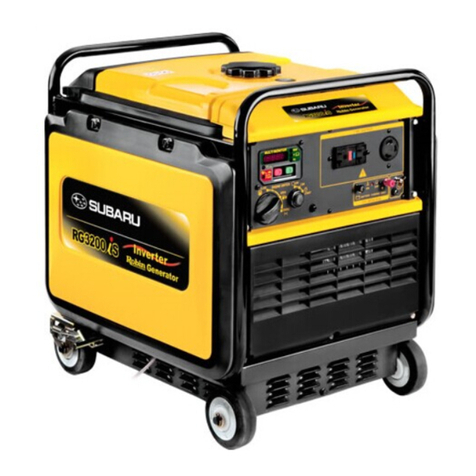
Robin
Robin RG2800is User manual
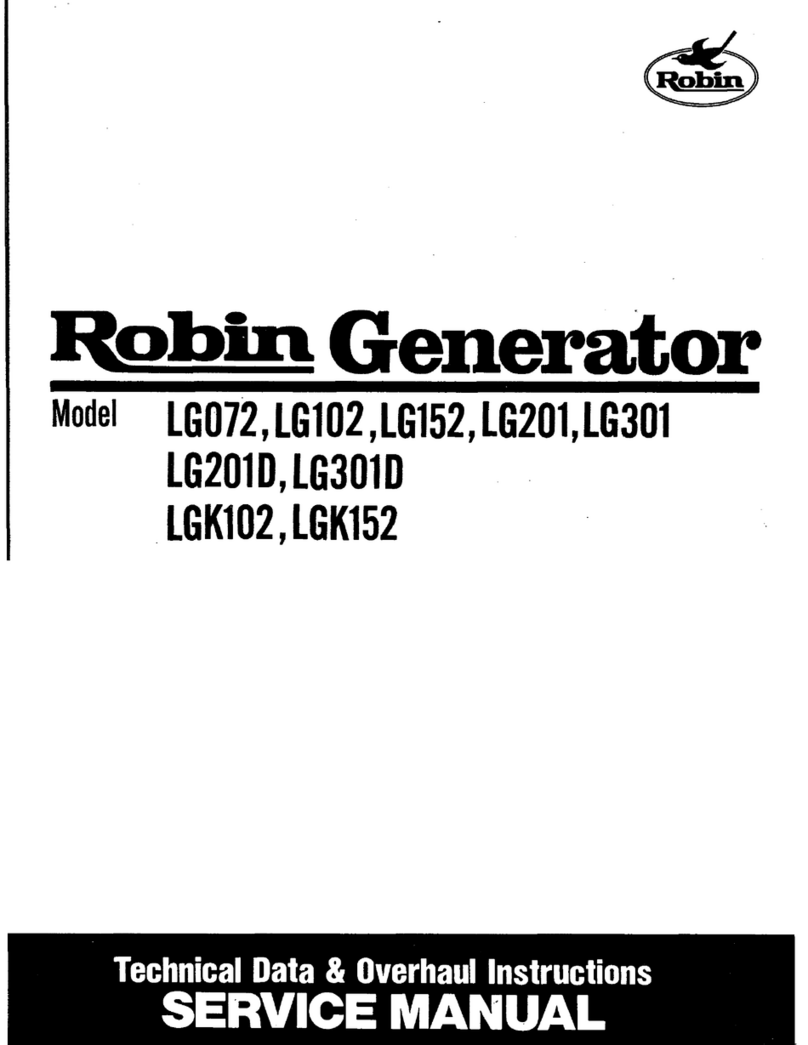
Robin
Robin LG072 User manual
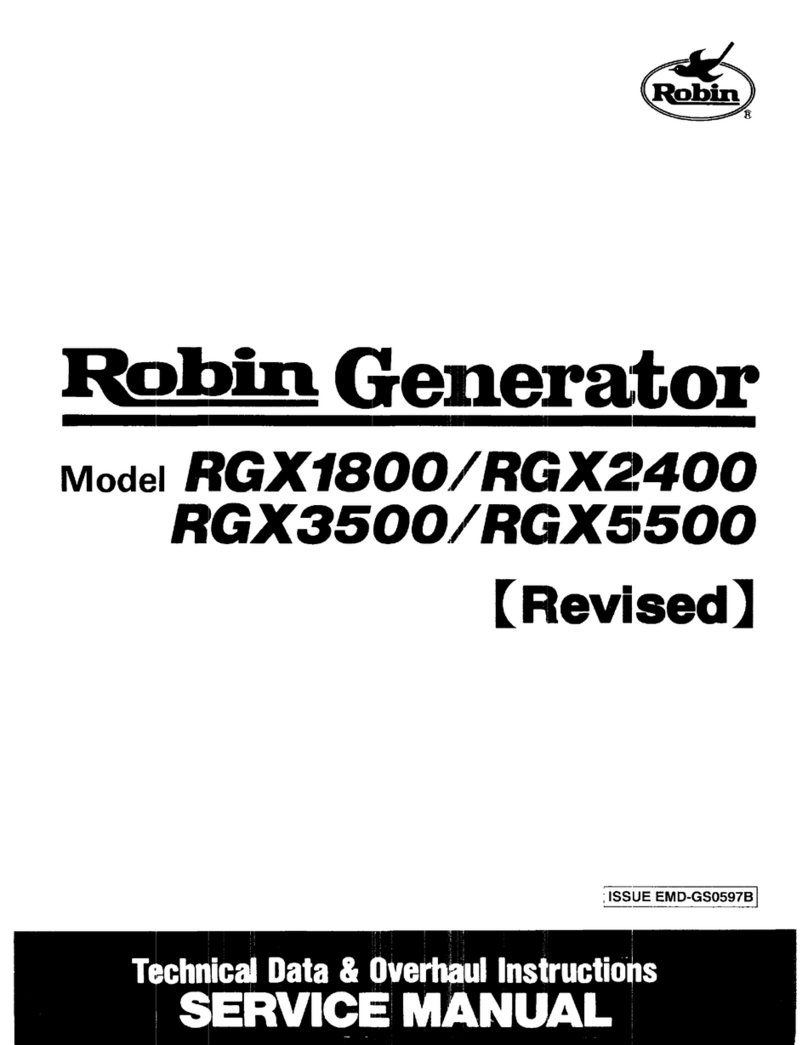
Robin
Robin RGX1800 User manual

Robin
Robin RGX305 User manual
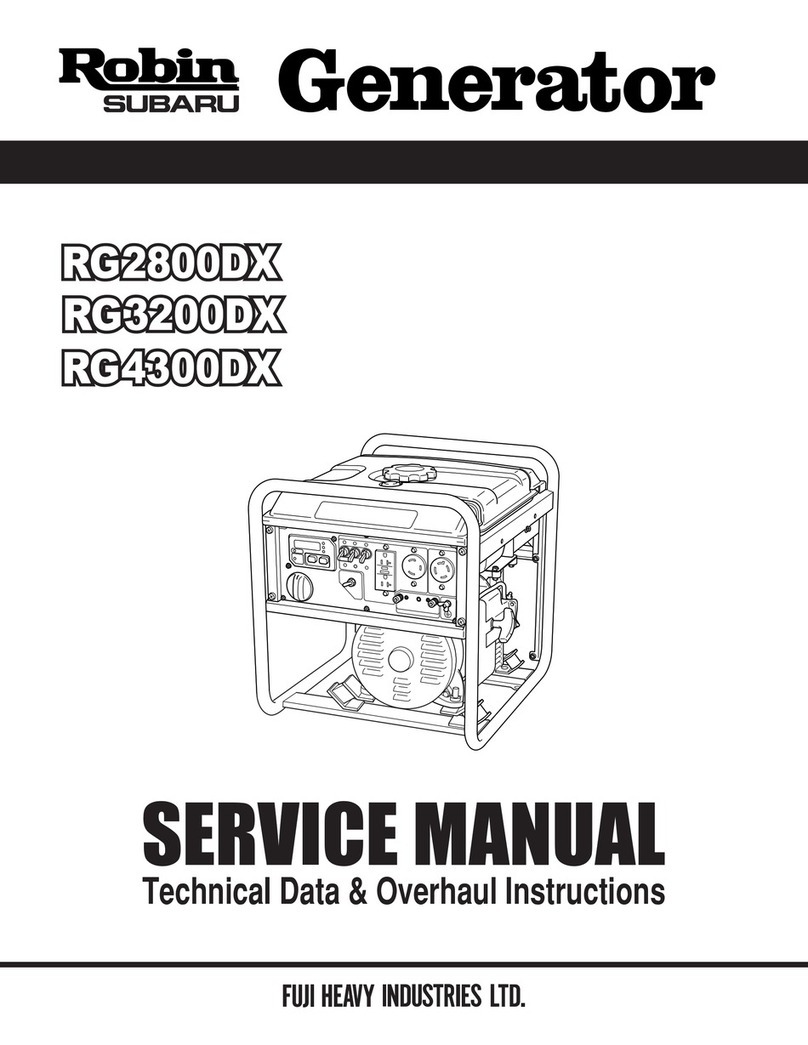
Robin
Robin RG2800DX User manual

Robin
Robin R650 User manual
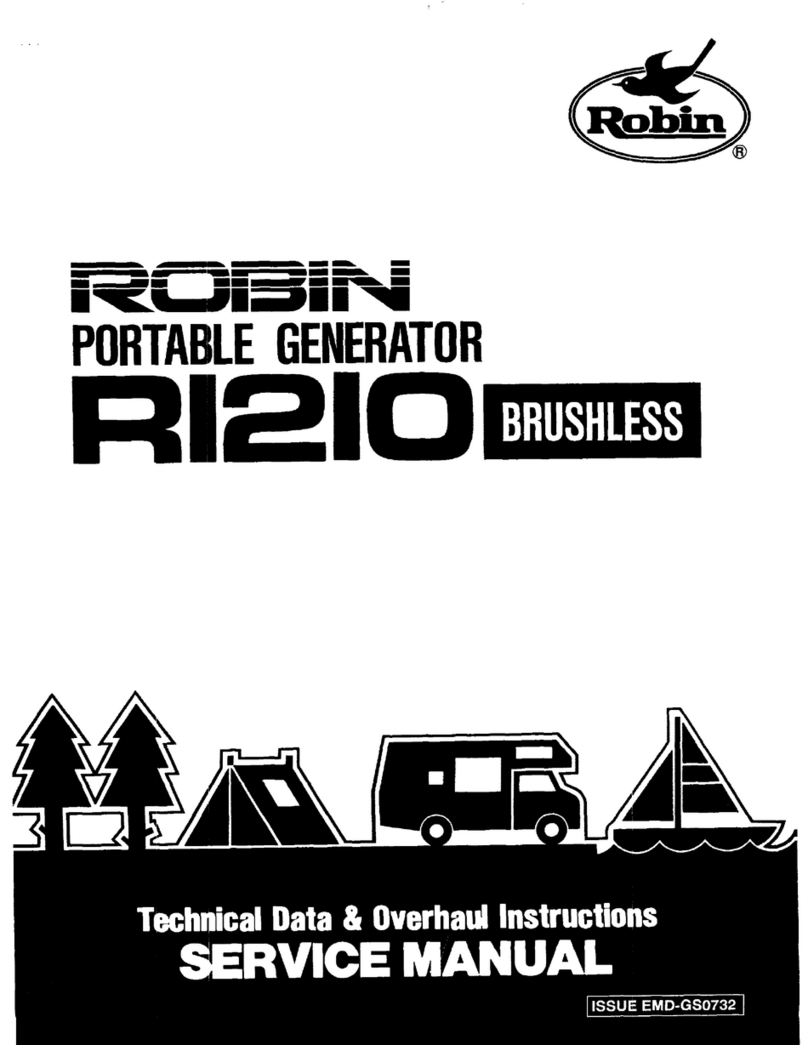
Robin
Robin R1210 Brushless User manual
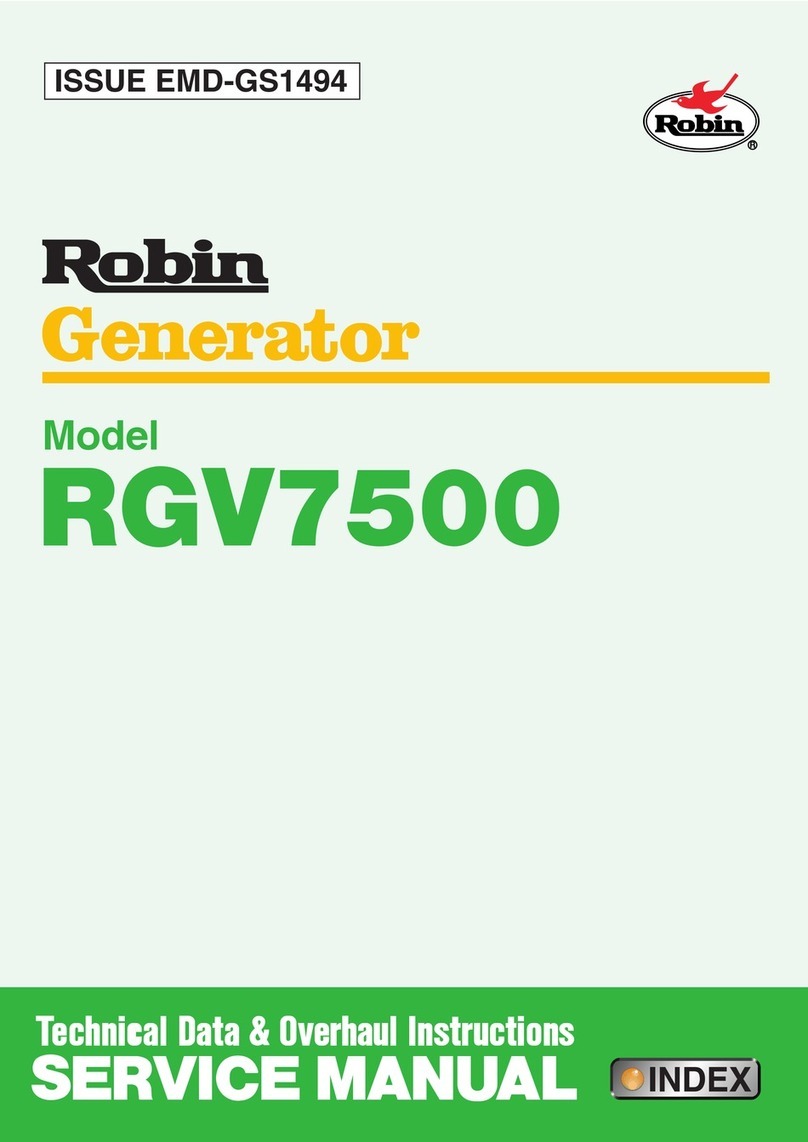
Robin
Robin RGV7500 User manual
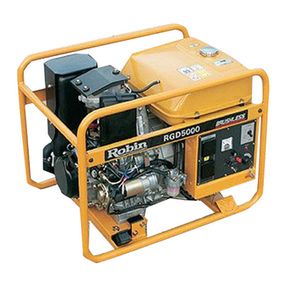
Robin
Robin RGD3700 Instruction manual

Robin
Robin R1300 User manual
Popular Portable Generator manuals by other brands
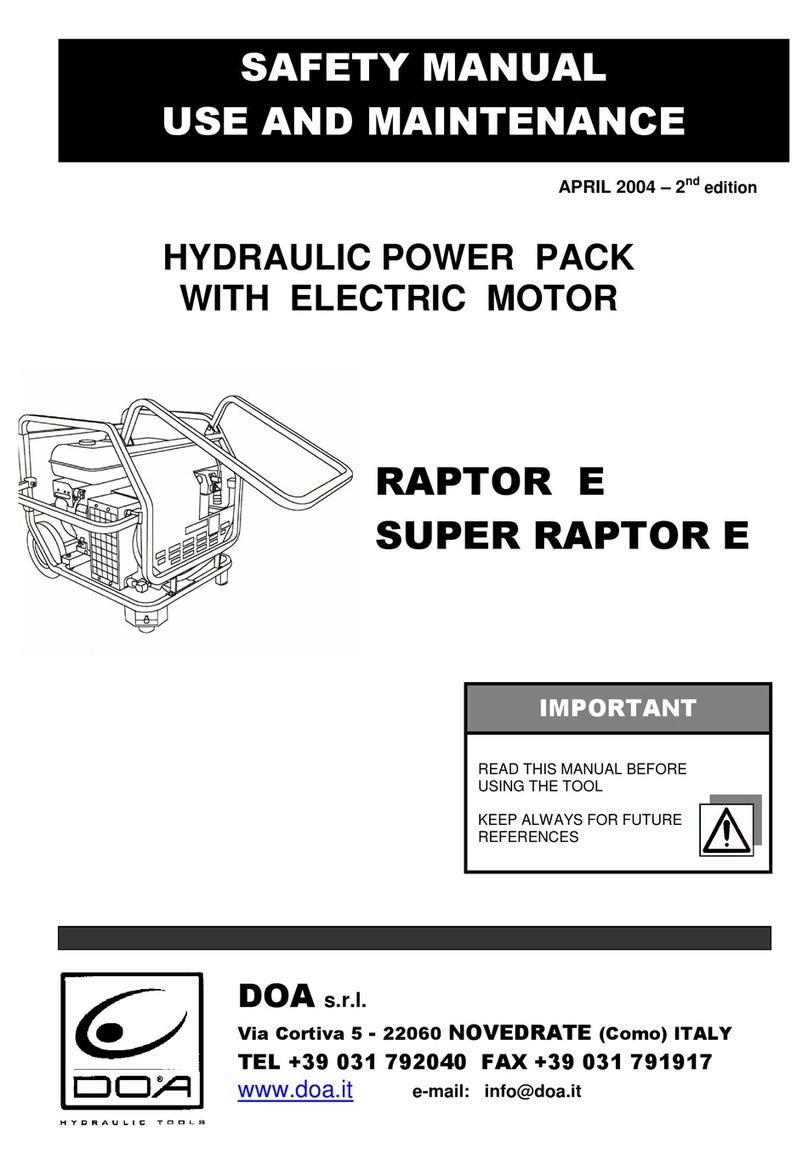
DOA
DOA RAPTOR E Use and maintenance
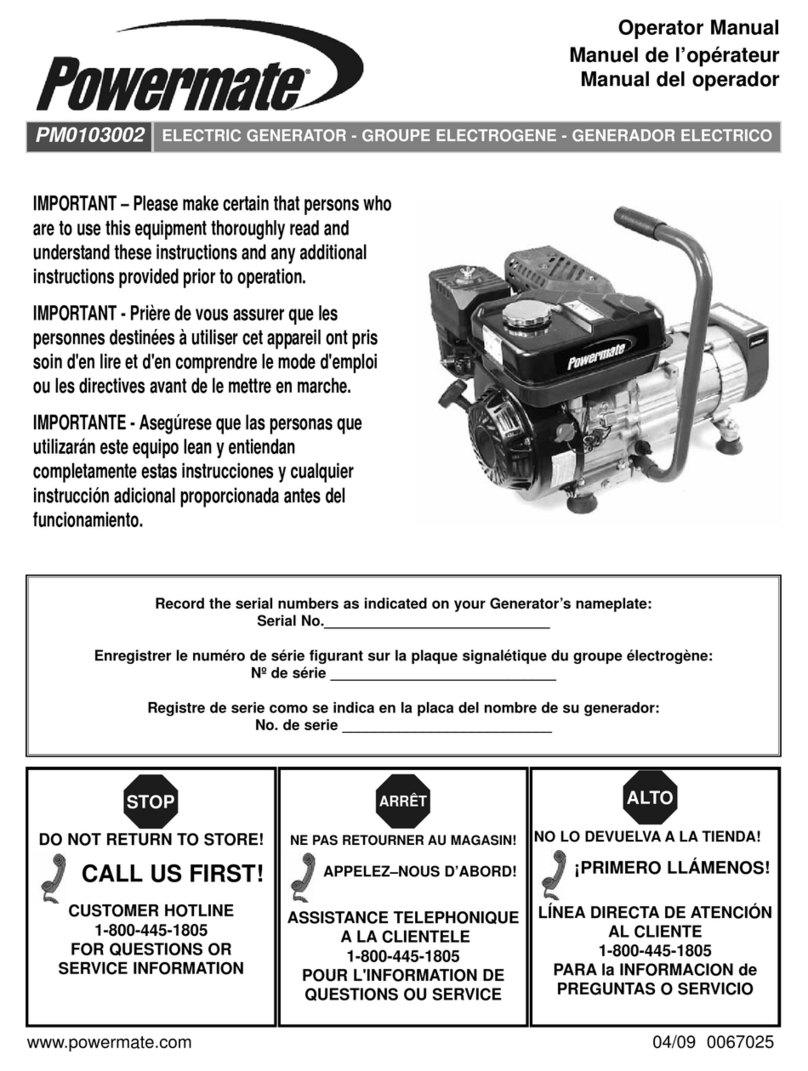
Powermate
Powermate PM0103002 Generator user manual
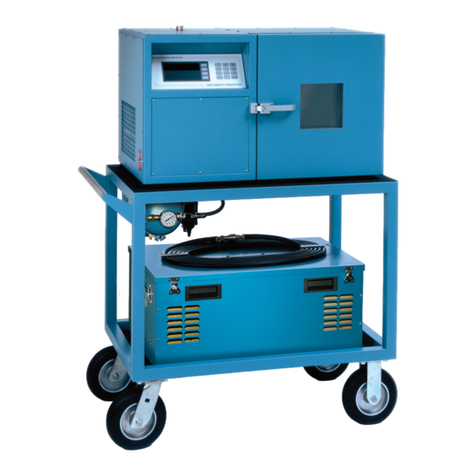
Thunder Scientific
Thunder Scientific 2500 series Operation and maintenance manual
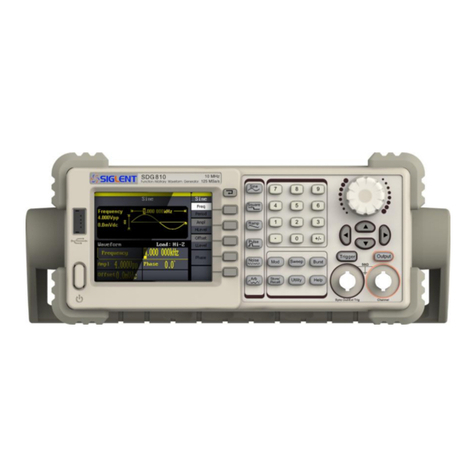
SIGLENT TECHNOLOGIES
SIGLENT TECHNOLOGIES SDG800 Series user manual
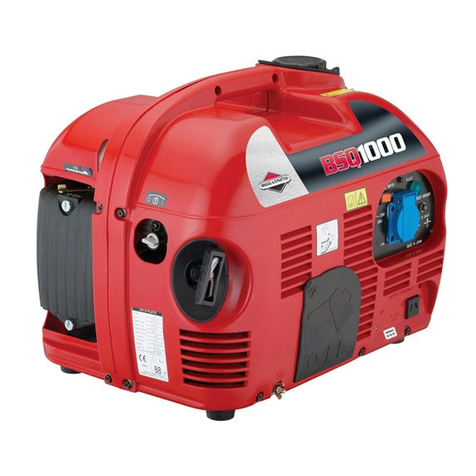
Briggs & Stratton
Briggs & Stratton BSQ 1000 owner's manual
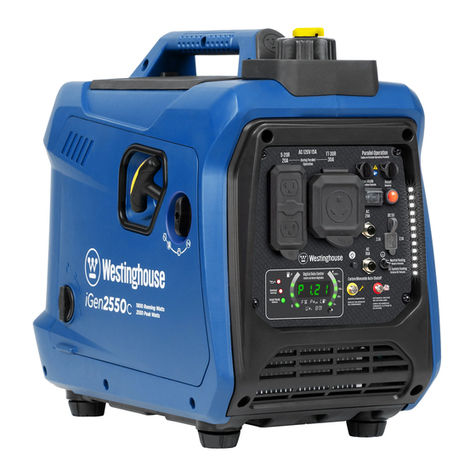
Westinghouse
Westinghouse iGen2550c quick start guide
